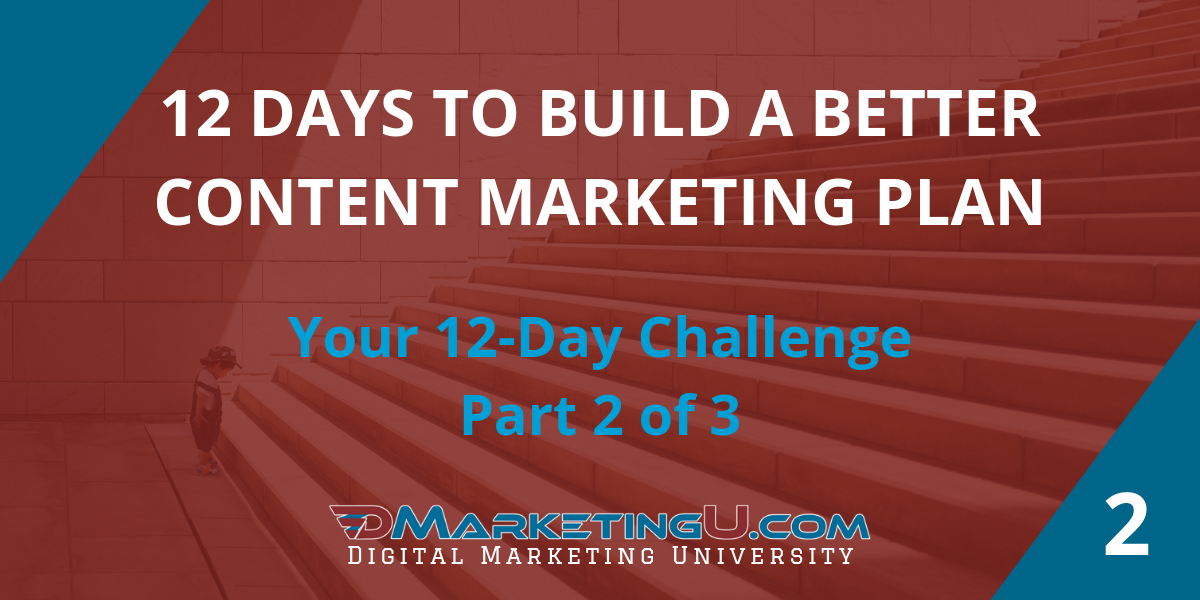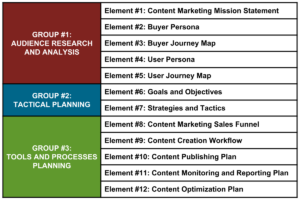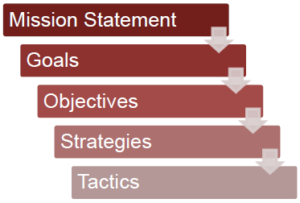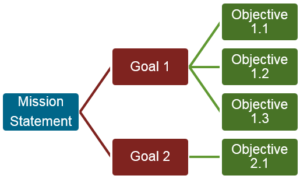
12 Days to Build a Better Content Marketing Plan: Part Two of Three
Which would you prefer if you were on a cruise ship — (1) a captain with a well-defined plan for your itinerary of exciting destinations or (2) a captain who hasn’t designed a plan, doesn’t have a good sense of direction, and can’t provide you with estimates for where you’re going and when you’ll arrive at destinations? For me, I love a good plan… whether it’s on a cruise or for my business. If you dream of being the “captain of your ship” and building a better strategic plan for your organization’s content marketing efforts, you’re just 12 days away from upgrading your plan… or building your first Content Marketing Plan!
Welcome to part two of our 12-day challenge to help you improve or build a better Content Marketing Plan. (All links to the 3-part series are in a section below) In this second part of our blog series, you’ll learn about the core of the plan… Goals, Objective, Strategies and Tactics.
But first, here’s more information about the challenge.
CHALLENGE OBJECTIVE
The objective of the 12-day challenge is to provide you with guidance and tips for improving (or creating) your Content Marketing Plan — which is a documented strategy to create, publish, monitor, report and optimize content to help you reach your target audiences, fulfill their needs, plus achieve your goals and objectives.
CHALLENGE QUICK LINKS
The 12-day challenge will be covered in our 3-part blog series. Below are the links to each article in the series:
Blog Post #1: Audience Research and Analysis
- Day 1: Content Marketing Mission Statement
- Day 2: Buyer Persona
- Day 3: Buyer Journey Map
- Day 4: User Persona
- Day 5: User Journey Map
Blog Post #2: Tactical Planning
[Links in this blog post!]Blog Post #3: Tools and Processes Planning
- Day 8: Content Marketing Sales Funnel
- Day 9: Content Creation Workflow
- Day 10: Content Publishing Plan
- Day 11: Content Monitoring & Reporting Plan
- Day 12: Content Optimization Plan
THREE GROUPS OF ELEMENTS IN A CONTENT MARKETING PLAN
Note: If you read this short section in blog post #1 of 3, it’s fine to scroll down or skip to Day 6: Goals and Objectives
When building a Content Marketing Plan, our experience and research has lead to the development of three key groups of elements that must be included in your strategic plan. Our definition of an “element” is a core component of a marketing plan that focuses on a strategic marketing area.
Group #1 – Audience Research and Analysis
Since the most important factor in any marketing plan is knowing the needs and challenges of your target audiences, the first group contains five elements related to Audience Research and Analysis. This was the group covered in the first post of our 3-part blog series.

Group #2 – Tactical Planning
Once you’ve invested time to thoroughly understand the needs and challenges of your audience, now it’s time to analyze your organization’s and department’s needs in the form of goals, objectives, strategies and tactics. This stage of analysis will be documented in the Tactical Planning section of your Content Marketing Plan. This group of elements will be covered in this current post of our 3-part blog series.
Group #3 – Tools and Processes Planning
After you’ve documented your audiences’ needs and your organization’s needs, the final stage is to create tools and processes that will help you improve your efficiency and productivity related to content creation, content publishing, monitoring, reporting and optimization of future and existing content. The Tools and Processes Planning group of five elements will be covered in the third post of our 3-part blog series.
Now that you’ve seen the objective and overview of the challenge, let’s get started with the next challenge!
DAY 6 OF 12 — Challenge #6: Goals and Objectives
On the sixth day of this challenge, the objective is to develop Goals for guidance and Objectives as measurable targets for you and your Content Marketing team. These will serve as the foundation for your Tactical Planning (Group #2 discussed earlier).
 Before starting the exercise for your Goals and Objectives, it’s helpful to understand their relationship with the upcoming Strategies and Tactics in the Day 7 Challenge. After your Content Marketing Mission Statement, next in the hierarchy for planning are your Goals, which are broad outcomes of WHAT to achieve (without measurements). Branching off of each goal is one or more Objectives, which describe WHAT to achieve with a measurement plus time to reach the related goal. Next in the hierarchy are your Strategies, that are generic statements HOW to achieve the objectives. And the most important actionable planning tool are your Tactics, that are specific actions on HOW to achieve the Strategies.
Before starting the exercise for your Goals and Objectives, it’s helpful to understand their relationship with the upcoming Strategies and Tactics in the Day 7 Challenge. After your Content Marketing Mission Statement, next in the hierarchy for planning are your Goals, which are broad outcomes of WHAT to achieve (without measurements). Branching off of each goal is one or more Objectives, which describe WHAT to achieve with a measurement plus time to reach the related goal. Next in the hierarchy are your Strategies, that are generic statements HOW to achieve the objectives. And the most important actionable planning tool are your Tactics, that are specific actions on HOW to achieve the Strategies.
Now, let’s learn the benefits of creating your Goals and Objectives. For a strategic plan to be successful, it must provide direction and guidance for the team. Therefore, the benefits are:
- documenting WHAT you are trying to accomplish and WHEN the deadlines occur.
- providing measurable targets to track your progress and achievements.
- assisting in decision making to make sure actions get you closer to your goals.
- driving motivation for individuals and the team to reach the goals.
- creating accountability to achieve the goals and objectives.
- using it as a reference tool for training department staff and team members.
With a better understanding of the advantages of Goals and Objectives, let’s investigate how to build the foundation of your plans. Let’s start with an example:
- Goal: Increase Brand Awareness. (broad outcome of WHAT to achieve without measurements)
- Objective: Increase Brand Awareness of our Facebook fan page to gain 1,000 fans within the next 6 months. (describes WHAT to achieve with a measurement plus time to reach the related goal)
First, create your Goal using a popular Content Marketing goal area such as any of the following:
- Brand Awareness
- Brand Advocates
- Customer Acquisition
- Customer Retention/Loyalty
- Engagement
- Lead Generation
- Lead Nurturing
- Sales/Conversions
- Thought Leadership
- Upsell/Cross-sell
- Website Traffic
Second, choose an action word to put in front of the Goal, using a positive word for an improvement (increase, grow, enhance, add, etc.) or a negative word for efficiencies (decrease, reduce, save, remove, etc.). Then, combine your action word + Content Marketing goal area to create your Goal! Remember the example of “Increase” + “Brand Awareness”.
Regarding creating one or more Objectives directly related to the Goal, follow these steps:
- Start with the Goal itself.
- Add a marketing channel or content marketing area related to the Goal that you want to change.
- List the measurement, milestone or achievement.
- Provide the time in the form of a deadline date or time period.

Since each Goal can have one or more Objectives, repeat the steps above for each marketing channel or content marketing area that you want to change related to the Goal. My recommendation is to number each Goal with an integer, then number each related Objective with a number and decimal, and increase the decimal for each Objective. (see Figure 1)
In our online course called “How to Create a Content Marketing Plan: 12-Step System for Success“, we have an entire 28-page chapter and video dedicated to helping you create your own Goals and Objectives if you want more help from hands-on exercises and step-by-step instructions.
Once you’ve documented a list of Goals and their related Objectives, complete the Day 6 challenge by listing them in a hierarchy of planning statements using bullets and indent the Objectives under their related Goals.
In your existing or new strategic plan, build a better Content Marketing Plan by inserting your new Goals and Objectives into the middle of your plan after the Buyer and User sections. The reason it belongs here is because it provides direction and guidance based on your analysis of your audiences’ needs from Group #1 and prior to the building of your tools and processes in Group #3.
Congratulations on completing the tasks for Day 6 of the 12-day challenge! Next in this blog post will be further tactical planning of your Strategies and Tactics.

DAY 7 OF 12 — Challenge #7: Strategies and Tactics
On the seventh day of this challenge, the objective is to develop Strategies as generic approaches to achieve an Objective followed by the creation of Tactics as specific action to achieve the related Strategy. While the Goals and Objectives served as the foundation of your Tactical Planning (Group #2), these new statements will be the core of your action plan defining HOW you will ultimately achieve your Goals.
When you develop a Strategy, it would be long-term and generic about HOW you want to achieve the Objective. But, the tactics differ because they should be short-term and specific and include a frequency or deadline so you can accomplish the related Strategy.
It’s critical to complete the planning phase by creating Tactics, primarily because the benefits are:
-
documenting HOW you will achieve success and WHEN the deadlines occur.
-
providing measurable targets to track your progress and achievements.
-
assisting in decision making to make sure actions get you closer to your goals.
-
driving motivation for individuals and the team to reach the strategies and tactics.
-
creating accountability to achieve the tactical plan.
-
using it as reference tool for department employees and new team members.

For this Day 7 challenge, pick your top Goal and its first Objective. The next step is to develop one or more Strategies to achieve that Objective. But first, here’s an example to learn from of a finished branch of a tactical plan within the hierarchy.
- Goal: Increase Brand Awareness. (broad outcome of WHAT to achieve without measurements)
- Objective: Increase Brand Awareness of our Facebook fan page to gain 1,000 fans within the next 6 months. (describes WHAT to achieve with a measurement plus time to reach the related goal)
- Strategy: Cross-promote across our social networks. (long-term and generic about HOW to achieve the Objective)
- Tactic 1: Cross-promote our Facebook page on our Twitter page once per week. (short-term and specific with a deadline or frequency)
- Tactic 2: Cross-promote our Twitter page on our Facebook page once per week. (short-term and specific with a deadline or frequency)
Now that you’ve seen the example and the relationship between each tactical planning element, it’s your turn to try! Follow these steps:
- Write your Goal as a broad outcome of WHAT to achieve.
- Write your Objective and include a marketing challenge + measurement + time to finish it.
- Write your Strategy with one method on HOW you will achieve the Objective while keeping it a long-term and generic idea.
- Write one or more Tactics on HOW you will achieve the Strategy while keeping it short-term and specific with a deadline or frequency.
After completing this first exercise, repeat the process by creating another Strategy for that Objective with one or more Tactics. When you’ve exhausted your ideas for Strategies under an Objective, then create a new Objective for the Goal and repeat the process. Or, create a new Goal!
Once you’ve created an entire list of tactical plans, complete the Day 7 challenge by documenting all of the plans into a hierarchical list. Then, in your existing or new strategic plan, build a better Content Marketing Plan by inserting your new Goals, Objectives, Strategies and Tactic into the middle of your plan after the Buyer and User sections.
Congratulations on completing the tasks for Day 7 of the 12-day challenge! This concludes part two of three in our blog series where you learned about Group #2: Tactical Planning. In our next post, you’ll discover the 5 key elements for Group #3: Tools and Processes Planning within your Content Marketing Plan.
CONCLUSION
To build a better Content Marketing Plan, we recommend building a section of your plan focused on Tactical Planning.
In this blog post, we provided two daily challenges containing elements for your plan focused on Goals and Objectives plus Strategies and Tactics. The Day 6 Challenge was to create Goals as broad outcomes on WHAT to achieve then write Objectives as descriptions on WHAT to achieve with a measurement plus time to reach the related goal. The Day 7 challenge was to develop Strategies as long-term and generic statement on HOW to achieve an Objective then build one or more Tactics as your short-term and specific action plan to achieve the Strategy.
Next in the 3-part blog series is your “Tools and Processes Planning” where you’ll learn about 5 key elements on how to improve your content creation, publishing, reporting, optimization and more! If you’re ready, click here to access the third post in the series.